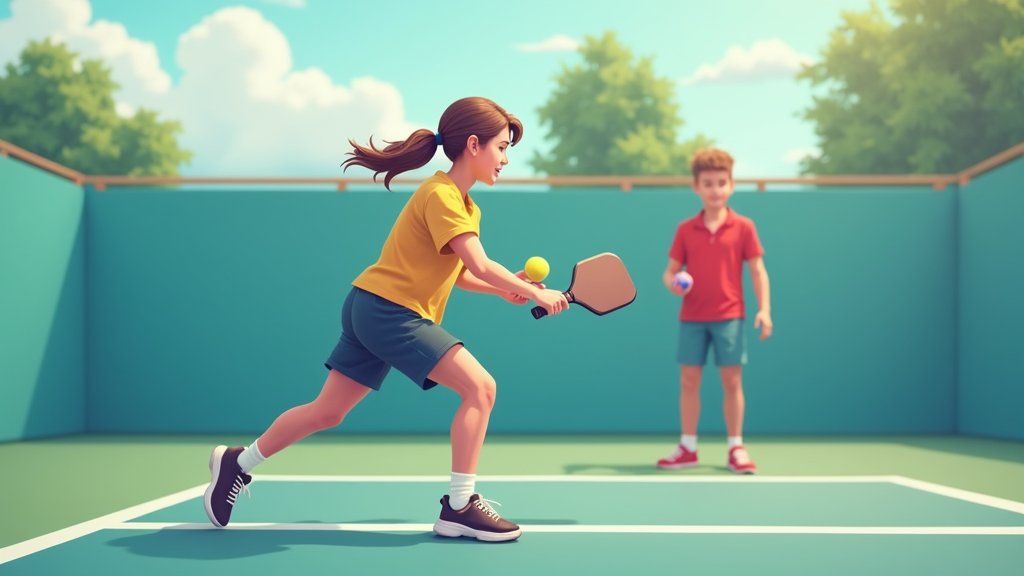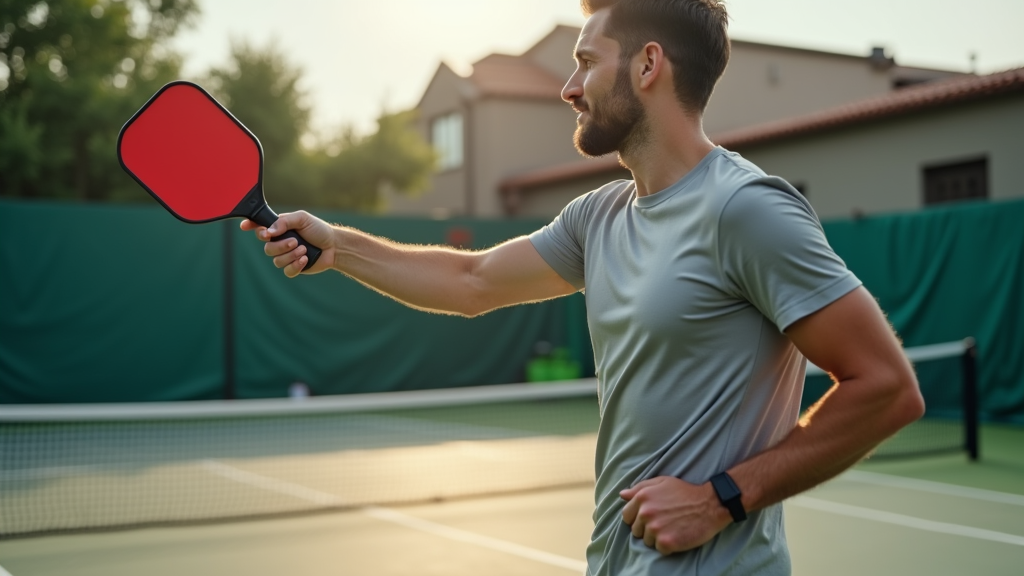Table of Contents
- Introduction to USA Pickleball
- Understanding USA Pickleball
- Rules and Regulations
- Tournaments and Events
- Resources for Players
- The Growth of Pickleball
Introduction to USA Pickleball

The Rise of Pickleball in America
Pickleball’s popularity has exploded in recent years, transforming from a niche pastime to a national phenomenon. By 2023, over 13.6 million people in the United States were actively participating in this engaging sport, a testament to its broad appeal and accessibility.
For three consecutive years, 2021, 2022, and 2023, pickleball has held the title of the fastest-growing sport in the U.S., showcasing its remarkable trajectory and capturing the attention of athletes and enthusiasts alike. This rapid growth reflects pickleball’s easy-to-learn nature, social aspects, and relatively low barrier to entry.
Further cementing its place in American culture, pickleball was officially named the state sport of Washington in 2022, a fitting tribute to its origins and enduring legacy in the Evergreen State.
A Brief History of USA Pickleball
The story of pickleball began in 1965 on Bainbridge Island, Washington. Faced with entertaining bored children, Joel Pritchard, Barney McCallum, and Bill Bell improvised a game using ping-pong paddles, a perforated plastic ball, and a badminton court.
What started as a backyard pastime quickly evolved into a structured sport, and in 1984, the United States Amateur Pickleball Association (USAPA) was founded in Tacoma, Washington. This organization played a crucial role in standardizing the rules and promoting the sport across the country.
That same year, the first official pickleball rulebook was published, providing a framework for consistent gameplay and laying the foundation for organized tournaments and competitions.
In 2020, the USAPA underwent a rebranding, becoming USA Pickleball, a name that better reflects its national scope and commitment to serving the growing community of players, coaches, and enthusiasts.
What You’ll Learn
This blog series will provide a comprehensive overview of USA Pickleball and its vital role in shaping the sport. You will gain a deeper understanding of the organization’s mission, its impact on the rules and regulations of the game, and the various opportunities it offers for individuals to get involved.
We will explore the key rules and regulations that govern pickleball play, highlighting any recent changes or updates implemented by USA Pickleball. This knowledge will enhance your understanding of the game and improve your ability to play competitively and fairly.
Finally, we will discuss the many ways you can get involved with USA Pickleball, from becoming a member and participating in tournaments to volunteering your time and contributing to the growth of the sport. Whether you are a seasoned player or a curious beginner, there are numerous opportunities to connect with the pickleball community and make a difference.
Understanding USA Pickleball
What is USA Pickleball?
USA Pickleball is the governing body for the sport of pickleball in the United States. It plays a vital role in shaping the landscape of the sport, from setting official rules to fostering growth at the grassroots level.
The organization’s core mission is to promote the growth and development of pickleball throughout the nation. This involves a wide range of activities, including sanctioning tournaments, certifying instructors, and providing resources to players of all skill levels.
Since 2005, USA Pickleball has operated as a 501(c)(3) non-profit organization. This status underscores its commitment to serving the pickleball community and reinvesting resources back into the sport.
Key Figures and Milestones
The foundation of USA Pickleball is rooted in the passion and dedication of key individuals who shaped its early years. Bryon Olson and Sid Williams are recognized as the key founders, laying the groundwork for the organization’s future.
In 1984, a notable moment occurred when Ronald Reagan was inducted as the first honorary member of USA Pickleball, receiving membership number 00001. This underscored the growing popularity and mainstream appeal of pickleball.
Frank Candelario took the helm as president in 1999, guiding the organization through a period of significant expansion and development.
The Nalley Fine Foods Company became the first sponsor of USA Pickleball, providing crucial financial support that helped to propel the organization forward.
A landmark achievement was the publication of the first Official Tournament Rulebook in 2008. This standardized the rules of the game and provided a consistent framework for competitive play across the country.
Related Organizations
While USA Pickleball focuses on the sport within the United States, several international organizations play a role in governing and promoting pickleball on a global scale.
- Global Pickleball Federation (GPF)
- International Pickleball Federation (IPF)
- World Pickleball Federation (WPF)
These organizations work to standardize rules, sanction international tournaments, and foster the growth of pickleball in countries around the world. They collaborate with national governing bodies like USA Pickleball to ensure a cohesive and consistent approach to the sport worldwide.
Rules and Regulations

Court Dimensions and Equipment
Pickleball is played on a court that combines elements of tennis, badminton, and table tennis, resulting in a unique and dynamic playing field. The dimensions and equipment are precisely regulated to ensure fair play and consistent gameplay.
- Play area: The standard pickleball court measures 20 feet wide and 44 feet long. This compact size allows for fast-paced action and strategic maneuvering.
- Non-volley zone (kitchen): A defining feature of pickleball is the non-volley zone, often referred to as the “kitchen.” This area extends 7 feet from the net on both sides of the court. Players are not allowed to volley the ball while standing within this zone, adding a tactical layer to the game.
- Net height: The net stands 36 inches high at the sidelines and 34 inches high in the center. This specific height encourages a mix of dinks, drives, and strategic net play.
- Approved balls: Pickleball balls are designed with specific characteristics to optimize gameplay. They typically weigh between 0.78 and 0.935 ounces and feature 26 to 40 holes. These holes help to reduce the ball’s speed and create a consistent flight pattern, making the game accessible to players of all skill levels.
Key Rule Changes for 2025
Pickleball is a sport that continues to evolve, with ongoing adjustments to its rules to improve fairness, clarity, and the overall player experience. Several key rule changes are slated for 2025, which players should be aware of to stay competitive and informed.
- Redefining the Volley
One significant change involves the definition and execution of a volley. A volley is defined as hitting the ball in the air before it bounces on the court. The updated rules clarify that:
- A volley starts when a player makes contact with the ball before it bounces.
- It is no longer a fault if a player touches the non-volley-zone (NVZ) before hitting a volley after making contact with the ball outside the NVZ. This change allows for more aggressive play near the net without penalizing players for incidental contact with the NVZ after the volley.
- Not Ready Signals
To promote better communication and prevent accidental plays, the 2025 rules will formally recognize verbal indicators to halt play. Specifically:
- Verbal indicators such as “stop” and “wait” will be recognized to halt play. This allows a player to stop a serve or return if they are not ready, preventing rushed or unfair plays.
- Changes to Serve Rules
The serving rules are also undergoing revisions to ensure consistency and prevent unfair advantages. The key changes include:
- The serve can be made using one hand or the paddle to release the ball. This provides players with more flexibility in their serving technique.
- The server cannot impart manipulation or spin on the ball with any part of the body or paddle during the release. This aims to prevent servers from gaining an unfair advantage through unnatural spin.
- A natural rotation of the ball during release is permissible. This allows for a small amount of spin that occurs naturally without intentional manipulation.
- Exception: The ball may roll off the face of the paddle by gravity. This accommodates players who prefer to let the ball roll naturally off the paddle face during the serve.
- Calling Faults
The rules regarding fault calls are being updated to emphasize fairness and integrity in gameplay:
- Players must call faults on their partners as well as themselves. This promotes honesty and accountability among teammates.
- If partners disagree on an opponent fault call, the call will favor the opponents, reflecting the principle that doubt benefits the opponent. This ensures that close calls are resolved in a way that upholds fair play.
Scoring System
Understanding the scoring system is crucial for playing and enjoying pickleball. The game’s unique scoring rules add a strategic dimension to each match.
- Step-back structure: Both singles and doubles matches require a two-point lead to win. This ensures that games are decisively won and prevents matches from ending prematurely on a single point.
- Game typically played to 11 points: In most recreational and casual games, pickleball is played to 11 points. The first side to reach 11 points with a two-point lead wins the game.
- Tournament games can extend to 15 or 21 points with rotation rules: In more competitive settings, such as tournaments, games may be played to 15 or 21 points. These longer games often incorporate rotation rules, where players switch positions after a certain number of points to ensure balanced gameplay and strategic depth.
Tournaments and Events
National Championships
The pinnacle of competitive pickleball in the United States is undoubtedly the Biofreeze USA Pickleball National Championships. This prestigious event draws players from across the nation to compete for titles and recognition. In 2023, the championships were held in Dallas, Texas, from November 5th to 12th, showcasing top-tier talent and thrilling matches.
Prior to the Dallas event, the 2022 edition of the Biofreeze USA Pickleball National Championships took place in the beautiful setting of Indian Wells, California. The change in venue highlights the growing popularity and expanding reach of pickleball across diverse regions of the country.
Qualification Routes
Aspiring national champions have several avenues to qualify for the main event. USA Pickleball has established a structured system of tournaments that provides opportunities for players of all skill levels to earn their spot.
- National Championship Series: This series comprises six regional championships held throughout the year. These regional events serve as key qualifiers, allowing top performers from each region to advance to the National Championships.
- USA Pickleball Diamond Regionals: This series leads to the USA Diamond Amateur Championship. This pathway offers another route for amateur players to showcase their skills and potentially qualify for higher-level competitions.
- National Indoor Championships: For those who prefer indoor play, the National Indoor Championships offer a competitive environment. In 2022, the event was held in Hoover, Alabama, while the 2023 edition took place in Atlantic City, New Jersey.
How to Participate
Pickleball tournaments are organized for players of all levels, from beginners to seasoned professionals. Whether you’re looking for a friendly local competition or aiming for national glory, there’s a tournament out there for you.
Tournaments typically offer multiple divisions and skill levels, ensuring fair and competitive matches. Players are grouped based on their age, gender, and skill rating, allowing everyone to compete against others of similar ability.
The registration process for tournaments is generally straightforward. Players can usually register online through the tournament’s website or through the USA Pickleball website. Be sure to check the specific registration deadlines and requirements for each tournament.
Many tournaments have established partnerships with local hotels to provide discounted rates for participants. This can help make travel and accommodation more affordable, especially for those traveling from out of town.
And now, for something completely different: don’t forget the upcoming Full Marathon Event on Sunday, October 7th, in NYC! While not pickleball-related, it’s a fantastic opportunity to challenge yourself physically and experience the energy of the city.
Resources for Players

Training and Development
Pickleball is a sport that rewards continuous learning and skill refinement. Luckily, there’s a wealth of resources available to help players of all levels improve their game. From beginners just learning the basics to seasoned veterans looking to fine-tune their technique, the pickleball community offers numerous avenues for training and development.
One of the most accessible resources is online content. You can find countless videos on platforms like YouTube, covering everything from basic stroke mechanics to advanced strategies and tactics. Many professional pickleball players and coaches have channels dedicated to providing instructional content. Articles are another great resource, often delving deeper into specific aspects of the game, such as footwork, court positioning, and mental toughness. Websites dedicated to pickleball often have libraries of articles and tutorials.
For more hands-on learning, consider participating in pickleball clinics. These clinics, often led by certified instructors, provide personalized feedback and guidance. They offer a structured learning environment where you can practice specific skills and receive immediate corrections. Check local community centers, pickleball clubs, and online forums to find clinics in your area. We also offer information about upcoming clinics and training resources directly on our website, so be sure to check the “Training” section regularly for updates.
Finding Information
We strive to provide a comprehensive and reliable resource for all things pickleball. However, we want to address a potential issue some users may encounter when trying to access external websites we recommend.
Recently, some users have reported encountering a security block notice when attempting to visit pickleheads.com. This notice indicates that your access to the site has been blocked by a security solution.
The most likely reason for this block is that your activity triggered a rule within their security system, potentially due to unusual traffic patterns or suspected malicious behavior. This is often a false positive, but it’s important to address the issue to restore access.
If you encounter this security block when trying to access pickleheads.com, we recommend the following action: Please send an email to the site owner or webmaster of pickleheads.com. In your email, provide detailed information about the block, including the Cloudflare Ray ID: 91078b379b8f53f9. Also, include your IP address, which is: 2600:1700:5e9d:b000:ed7b:4110:4e9d:e504. This information will help them diagnose the issue and unblock your access. We apologize for any inconvenience this may cause and are working to ensure a seamless experience for our users.
The Growth of Pickleball
Professionalization
Pickleball’s rapid ascent has naturally led to increased professionalization of the sport. A significant milestone was the establishment of two professional tours and two professional leagues in the United States in 2019. This marked a turning point, signaling a structured and competitive environment for elite players.
Further solidifying pickleball’s professional status is the creation of dedicated venues. “The Fort,” the world’s first stadium built specifically for pickleball, is set to open in Fort Lauderdale, Florida, in 2024. This venue will undoubtedly become a central hub for tournaments and events, boosting the sport’s visibility and appeal.
Media coverage is also playing a crucial role in professionalizing pickleball. The launch of PickleballTV in November 2023, a streaming service co-owned by the Tennis Channel and the United Pickleball Association, provides fans with extensive access to live matches, replays, and other pickleball-related content. This partnership brings the sport to a wider audience and enhances its legitimacy.
Global Expansion
Pickleball’s popularity is not confined to the United States; it’s experiencing significant global expansion. Professional leagues are either operating or planned in countries like Australia and India, demonstrating the sport’s growing international appeal. This expansion creates new opportunities for players and fans worldwide.
Currently, the top countries with registered pickleball players include the United States, Canada, Australia, the United Kingdom, and Malaysia. This diverse list highlights the sport’s broad appeal across different continents and cultures. As pickleball continues to grow, we can expect to see even more countries joining this list.
Concerns and Injuries
While the growth of pickleball is exciting, it’s important to address the associated concerns, particularly the rise in injuries. With more people playing, there has been a corresponding increase in pickleball-related injuries. This is a natural consequence of increased participation, but it’s crucial to understand and mitigate the risks.
The treatment costs associated with these injuries can be substantial, and certain body parts are particularly vulnerable. Wrist, elbow, and shoulder injuries are commonly reported among pickleball players. These injuries often result from repetitive motions, sudden stops and starts, and the physical demands of the sport. As pickleball continues to evolve, it will be important for players to take preventative measures to reduce the risk of injury.

